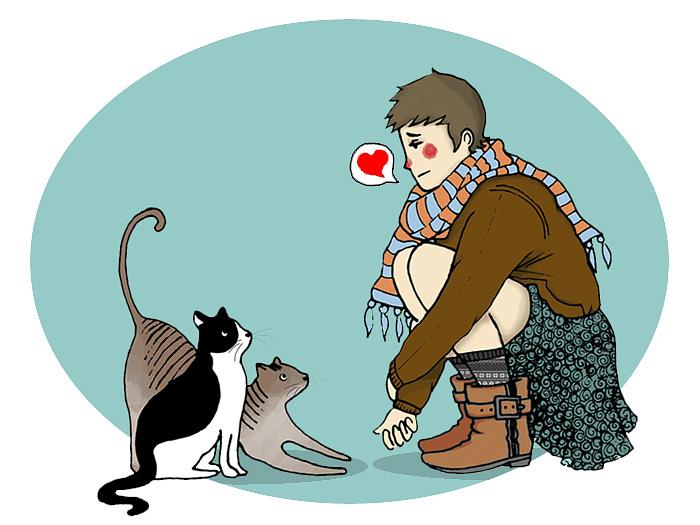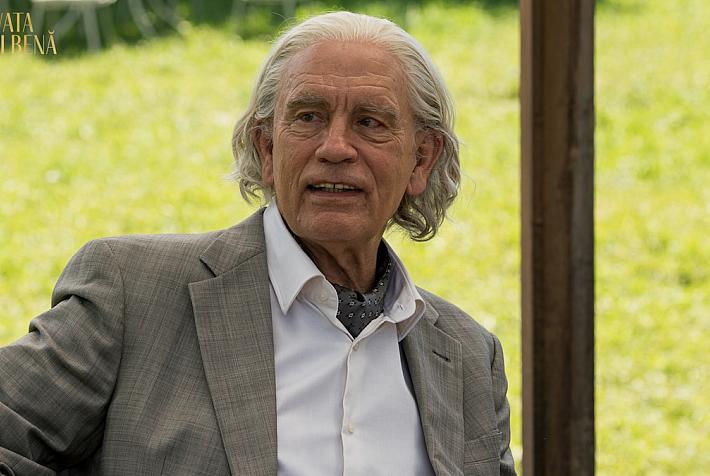Gravity. A young woman discovers life in the shadow of death

In 2013, Smaranda Milu Némethi was always on the run. A tall, gentle woman with long hair and broad shoulders, she was running 10 kilometers daily. She loved how it felt to be in the open air. She was planning motherhood. Back then, Smaranda ran a creative agency with her husband, Dan Ioan Milu, and they were always trying to find new clients. It was sometimes frustrating.
She had worked for years as an art director for big advertising agencies in Bucharest and Dan was a photographer. They had first been best friends, then lovers and business partners, then they got married. He was the more talkative one, whereas Smaranda loved to be by herself. Growing up in Carei, a small town in northern Romania, Smaranda would go out in the fields and paint.
But at 32, her life was hectic. She wrote in her diary that year: “I want a change in my life, something totally unexpected that I can’t control, but something that can change my perspective on life and open new doors towards worlds I never knew they existed.”
She never thought that it would be cancer.
***
In 2007, Smaranda was invited to exhibit in Bucharest her art collection “The anatomy of a kiss” for which she had worked over one year. The 26-year old woman, who had graduated from the Art University in Cluj-Napoca, crammed into a taxi her ten large canvases showing images of couples kissing and travelled from Carei to Bucharest.
At her vernissage, Smaranda wore red tights, a black skirt and a black sweater. The largest canvas was a four-piece panoply, of three by four meters. Next to the painting, the young woman seemed small. In one of the pictures of that vernissage, she speaks in front of a microphone, smiles and seems confident. But in reality Smaranda was very shy. Her mouth would go dry if she even had to ask somebody what time it was.
In high school, a blond, bad-boy 12-grader once asked her to go to a party. She was in the 10th grade, and when she heard the question, thousands of yeses burst into her head. But all she could say was a silent, skeptical “Do you want me to go with you?” The boy replied disappointed “Nevermind” and walked away.
Smaranda continued to be shy even in her late 20s, when she started working as an art director in Bucharest. She discovered her courage only after radiotherapy: “a Hiroshima on my brain”.
 Smaranda in her workshop, January 2016
Smaranda in her workshop, January 2016***
It is a sunny Saturday, January 2016. Smaranda is chatting with Valentin Ajder, a friend from Cluj-Napoca, a bearded, 50-year old man who owns a publishing house. They’ve met in the Starbucks Vitan cafe, in Bucharest, but none of them ordered coffee. Smarands loves Rooibos tea too much and Valentin has high blood pressure.
They are old friends, and he tries to convince Smaranda to gather her stories in a book. Ever since she was diagnosed with stage 4 cancer, she began writing on her blog about her experiences.
Smaranda wears a yellow sweater that emphasizes her rosy white skin, a denim skirt and long boots. The short brown hair frames her dimples and the childish, serene face. She also wears a necklace with a small silver pendant she bought in Stockholm. It represents the Swedish crown. In 2014, Smaranda went on a ten-day trip by herself to Stockholm right before she started radiotherapy. She knew that it was a dangerous procedure that could severely affect her, even lead to paralysis. “Before I turned stupid, I decided to see Sweden,” she says jokingly. When she got off the plane and saw a 20-kronor banknote with Nils Holgersson she felt at home.
She starts humming a song from her childhood about Nils Holgersson. Smaranda is also an attentive listener, and jokes a lot with her friend.
Her mouth is dry, but not because of shyness. It’s because of the drug she takes - Ceritinib -whose side effects include mouth sore. The drug is used for the treatment of ALK-positive metastatic non-small cell lung cancer. It is a type of genetic mutation in the most common form of lung cancer. People who get it are usually young, non-smokers, like Smaranda.
***
Smaranda received her first diagnosis at the end of 2013, around Christmas. She went to spend the holidays with her husband’s family in Bacau and took her two cats with her, Eva and Kara. Some months ago, a friend had given Smaranda an abandoned kitten whom she named Eva. The surprise was that the four-month cat was pregnant; a baby with babies, how Smaranda puts it. Eva gave birth to two kittens. One of them looked like caramel, and Smaranda called it Karamela, or simply Kara. She gave the other kitten to her parents.
On December 24, Smaranda received the results of her chest x-ray and saw the polka dots, as she calls the tumors. She tried not to panic. “We were all faking smiles. It was Christmas. We were pretending that the white spots on my first lung rays were only an untreated cold.”
Back in Bucharest, Smaranda started the investigations. She received different diagnoses, one of them saying she had squamous cell carcinoma, a type of cancer that is impossible to beat. But she was also diagnosed with multiple tumors in the right lung and brain tumor.
When Smaranda understood that it was cancer, she cried the whole day. But then she came to realize that eventually, it all comes down to two options. “To spend my remaining time crying or to spend my remaining time laughing”.
Facebook brought a twist to the story.
Several people told Smaranda that she shouldn’t talk much about her illness. She should rather hide it like some painful truth. But she didn’t want to sweep it under the carpet. She wrote on Facebook that she was diagnosed with cancer. “It wasn’t a venereal disease, and even if it were, I should first accept it to be able to heal it,” she says.
 Smaranda in her studio, January 2016
Smaranda in her studio, January 2016People reacted differently at her Facebook status. Some thought she was making a joke, others were worried.
The wife of a friend of hers saw her post. They couldn’t believe that Smaranda had cancer. She was young, doing a lot of sport and she had never smoked. The friends, who were living in Germany, arranged for her to be hospitalized in Germany.
She had stage 4 cancer, indeed. But it wasn’t squamous, the untreatable cancer. It was a rare form of cancer, a mutation.
The bad news was that the mutation was responsible for the dissemination of the cancer cells. The good news was that there is treatment available for this mutation. The pills are a sort of revolution for these types of cancer. They have fewer side effects, and directly target the cancer cells. In many of these cases, chemotherapy wouldn’t work. However, the drugs are very expensive. Crizotinib alone is 6,500 euro a month. If the body develops resistance to it, like it happened to Smaranda after one year, you have to move to another drug called Ceritinib that costs 8,000 euro a month.
If she wanted to survive, Smaranda needed to use all her ingenuity. Her main resource had always been creativity.
As a little girl, she would draw everything she read about, the characters from the Uncle Tom's Cabin and all the books she loved; sometimes she would write in her diary. It was the fantastic universe of a lonely girl who would run in the garden every morning to see how the tulips were blooming. But now Smaranda had to open up and invite others into her world.
She and her husband launched the website helpsmaranda.com and started a campaign to be able to pay for the pills.
***
January 30, 2014, Bucharest: “After 3 days spent wearing the pajamas of Marius Nasta hospital, without doing surgery because the hospital is overcrowded, I decided that I’m far too frivolous and too inconsistent to spend more time leading this disease to the end. I am firmly committed to healing in the shortest time possible. I have plans for this year. No time to waste on such nonsense! After the mediastinum surgery called mediastinoscopy, I took a picture with my caretaker “Bill Murray”.
This was one of Smaranda’s blog posts. Below the text, there are two photos. One of them shows her smiling, next to her caretaker, a tall, thin man, bold in the front, who has combed his hair back. He has the discrete smile of Bill Murray. In the picture, you can see in the background other people who are maybe patients or family visiting. They look sad and tired.
Smaranda is wearing the hospital’s striped pajamas, and she has just underwent surgery for removing tumors from her mediastinum - the central compartment of the thoracic cavity. But despite that, she has a genuine, bright smile on her face. It’s the laugh of a woman who, despite everything she is going through, hasn’t lost her humor and has even noticed that one of her caretakers looks like Bill Murray.
It’s humanity sneaking in in most desperate situations.
Smaranda began documenting her story. More and more people started reading it.
In Germany, she stayed at her friends’ house on the Usedom Iceland. While waiting for her diagnosis, Smaranda would put on her running gear every morning and run a few kilometers through the woods until she reached the sea.
March 1, 2014, Usedom Iceland, Germany: “Every morning when I wake up, I think that at the end of my jogging ritual in the woods, there’s something special waiting for me that I just can’t get tired of. The Baltic Sea, in all its northern splendor, rolls her lazy, cold waves on the beach at the edge of the forest, which in turn, displays her morning secrets with the grace of a good fairy. I admit that in a hidden corner of my mind, I always hope to meet a magical creature, in the woods or by the sea on one of these cool mornings, to grant me a wish.”
As months went by, she felt on a rollercoaster. She first heard that her cancer could be treatable, but the pills are impossibly expensive. Then she learned that they are not yet approved in Romania, and the insurance didn’t cover the expenses. Doctors later discover that she has another brain tumor, the third one.
But Smaranda made another discovery. “I was surprised to find out that my attitude has become an inspiration for other, healthy people.”
People were reading her blog in search for hope. Smaranda was somehow reminding them about things they had forgotten; and many were donating to keep their hope alive.
****
Radiotherapy was the most traumatizing experience. Doctors had discovered another brain tumor, which could be removed only through radiation therapy.
“When your knee hurts, for example, you can try to think about something else and make the pain go away,” Smarands says. “But when you brain hurts, there is nothing you can do. You are trapped with yourself.”
The experience reminded her of the movie Gravity, where an astronaut played by Sandra Bullock is stranded in space after the destruction of their space shuttle. The film shows the despair of being caught in the infinity of space, all by yourself and with no escape.
Smaranda was trapped with herself in pure pain.
Gravity is a natural phenomenon by which all things with energy are brought towards one another. Without gravity, the universe would be an uncomplicated one, existing without thermal energy and composed only of equally spaced particles. On Earth, gravity gives weight to physical objects and causes the tides.
For Smaranda, her cancer acted a bit like gravity. It brought her towards herself. The illness gave weight to her true feelings. No more pleasing everybody, no more losing time just to be polite, no more forgetting about what you want.
“When you are kid you know exactly who you are,” Smaranda says. “You know precisely what you like and what you don’t like. Then you go to school and you become a pupil. Then you become the young woman at the art high school. Then you fall in love and become someone’s lover. Then you become the student enrolled at the University of Arts. Then you become the art director. But all these are just layers that change you based on society’s requirements. After radiotherapy I stripped down all these layers.”
Smaranda returned to herself and met the five-year old girl who knew exactly what she liked. When she wanted something, she WANTED it. “You didn’t have to be somebody’s daughter, you didn’t have to create a powerpoint to justify what you want. You simply knew what you wanted.”
Smaranda wrote on her blog in April, 2014: “Against all expectations, the disease burst in me a sudden desire to live”.
When other cancer patients would write or call her, desperately afraid they will die, Smaranda would also remind them that they still have time left, and they shouldn’t waste it. “You know the cartoons with Snoopy? He has this dialogue with a friend: ‘Someday, we will all die, Snoopy! True, but on all the other days, we will not.’ “
 Inside Smaranda’s workshop, downtown Bucharest, January 2016
Inside Smaranda’s workshop, downtown Bucharest, January 2016She began painting again. At her parents’ home, where she spent time after radiotherapy, she noticed all the small things in the house that went unnoticed but made life more beautiful: tea cups, china figurines, vases, clocks. She painted each of them. A small piggy bank fills the entire canvas. It is not an old, shabby, forgotten-in-the-attic object anymore. Smaranda puts it in the limelight and makes it look important.
These type of paintings are called still-lifes, for they depict mostly inanimate subject matter. But they can also be the symbol of stepping away from the chaos of everyday life, looking around you and keeping life still for a while.
Smaranda’s latest collection is called “Little things”.
****
Two years after starting treatment, the fight has not become easier for Smaranda. When she goes to the little studio in downtown Bucharest where she paints, she always smiles to Stela, the woman who works at the flower shop nearby. She is patient with all the people she meets during the day, even if the previous night she couldn’t sleep because of vomiting or diarrhea.
Smaranda still needs to find over EUR 8,000 every month to survive. She is dependent on others’ donations to stay alive. But she thinks there is a good side to this. She has to be creative, paint, write on the blog.
When asked how she sees her future, Smaranda answers: “My friends’ present is my future. One day me and my husband will move out from our little place and we’ll live in a house with a garden. We will have kids, if not our own kids, we will adopt, and it will be exactly the life we have always wanted.”
“It’s very easy to die,” Smaranda says. “To live is a lot of hard work; but to really live, not just survive.”
If you want to make Smaranda’s quest for life a bit easier or just read her stories, go to her blog.
By Diana Mesesan, features writer, diana@romania-insider.com
(Opening illustration by Adela Crisan, photos by Diana Mesesan)











